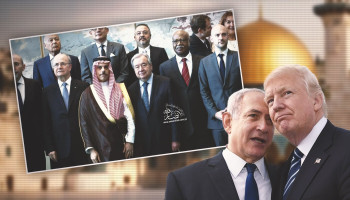Before Donald Trump boarded his flight to the Gulf, he delivered yet another round of insults to the region’s ruling regimes. In his speech, he reiterated comments made during his previous presidency, this time expanding them to cover all Gulf nations, stating that they would not exist without American protection. With that, Trump effectively set the tone for his visit, which some attempted to portray as "historic," pinning broad hopes on it, especially with regard to halting the ongoing genocide in Gaza carried out by Zionist Jewish militias with overt American backing.
A Visit from American Deals
If there was any success during this visit, it was exclusively in Trump’s favor. The American president walked away with billions of dollars secured through arms, aviation, and investment deals—figures that are truly astronomical, enough to excite the appetite of a cunning businessman and feed both his ego and greed. These deals also serve Trump’s plans to reduce America’s soaring national debt, which has surpassed $36 trillion.
Saudi Arabia alone is pumping $600 billion into the American economy through various investments. It also signed the largest arms deal in history, exceeding $140 billion. Qatar followed with a $200 billion deal to purchase 160 Boeing aircraft. The United Arab Emirates, for its part, had previously announced it would inject over $1 trillion into the U.S. economy over the next decade. Just this past Monday, ahead of Trump’s arrival, the UAE signed a $1.4 billion arms deal.
Saudi Disappointment
For Saudi Arabia, the visit amounted to little more than a media campaign to promote what Saudi outlets call “the Kingdom’s global stature and the Crown Prince’s ability to build alliances and shape the future.” But in reality, no alliance was formed; rather, the Kingdom remains a mere follower of the United States. As for the “future,” the grand Vision 2030 plan remains mired in setbacks. Even with both oil and non-oil revenues flowing into the public treasury, the Kingdom’s economy is burdened with debt. Saudi Arabia ended 2024 with a deficit of 115 billion riyals—its ninth consecutive quarterly deficit since 2022—raising the Kingdom’s total public debt to 1.22 trillion riyals, or more than $320 billion.
Financial issues aside, Riyadh had hoped to sign nuclear agreements and receive security guarantees. Yet nuclear matters were not even mentioned, and the security pledges amounted to nothing more than polite verbal assurances from Trump.
One thing that might be credited to Mohammed bin Salman is Trump’s decision to lift sanctions on Syria and a meeting arranged between Trump and Abu Mohammad al-Julani, securing, in effect, a Syrian seat for Riyadh at the expense of Turkish influence, which may soon face increasing competition.
What About Qatar?
In the lead-up to Trump’s visit, Qatari media—led by Al Jazeera—promoted the idea of a breakthrough in Gaza. During this time, Qatar pressured the resistance to release Zionist-American captive Edan Alexander, presenting it as a “gift” to Trump in hopes of a reciprocal gesture for Gaza.
Trump, in that period, made statements interpreted as disagreements with Netanyahu over Gaza, particularly concerning humanitarian aid. He called the war “brutal,” sidestepped his usual rhetoric about forced displacement, Israeli “decisiveness,” and even support for Israel in war, opting instead for words, not action. Observers hoped this might foreshadow results in his upcoming visit.
On Wednesday, the prince of Qatar held a closed two-hour session with Trump. However, after the meeting, Trump made statements only regarding Ukraine, Russia, and Iran, without a single mention of Gaza.
Gaza was undoubtedly discussed in some form, but it’s clear that not even a temporary ceasefire or the minimal entry of humanitarian aid, now rotting at border crossings due to Israeli blockade with U.S. support, was achieved. This constituted a devastating blow to the Qatari narrative, which had hoped for at least a symbolic win on par with the sanctions relief for Syria that Trump handed to Riyadh.
Trump and the Illusion of Peace
Welcoming ceremonies in both Riyadh and Doha overflowed with flattery for Trump, centered around “peace.” Trump was hailed as a man of peace, with thanks offered for his "efforts for peace." Yet when it comes to our region—our Arab and Islamic nations, which these hosting leaders are supposed to represent—Trump is a man of war and death. Gaza stands as the clearest example of his direct and indirect support for ongoing atrocities.
Some might argue that such praise is merely a tactic to nudge Trump toward peaceful action. But his visit is nearly over, and he has not even hinted at choosing peace, especially in Gaza.
Who Needs Whom: Trump or the Gulf States?
The Guardian wrote on the eve of Trump’s arrival that Gulf leaders are capable of shaping and redirecting Trump’s policy, asserting that he needs them more than they need him. But this reality seems absent from the minds of Gulf rulers, who remain obsessed with Trump’s narrative of “needing protection.”
But protection from whom? Why do they feel unstable, afraid, and anxious? Can they not see that reconciliation with their own people is the true path to security, and that regional harmony is the shortest and most effective route to peace and stability?
If these regimes are pouring such vast sums into Washington, why not leverage that to influence American decision-making? Why haven’t they learned the art of using astronomical figures to become true partners in shaping U.S. policy? Sadly, they still seem very far from that level of thinking.
Can America Still Provide Protection?
A few years ago, that question may have had a different answer. But today, after repeated failures by the American military—whether in defending the Zionist entity or even its own aircraft carriers in the Red Sea—the picture is clearer. Five American carriers were forced to reposition to counter Yemeni armed forces, and the last one, USS Truman, reportedly made a sharp evasive maneuver (if U.S. accounts are accurate) that led to the loss of F-18 Super Hornet aircraft.
Add to that the failure of THAAD and Patriot systems, the month-long U.S.-led military campaign against Yemen that achieved none of its goals, and Yemeni air defenses nearly downing F-35 jets, forcing American pilots to evade incoming missiles.
So what protection are these countries still hoping for—from Trump and a Pentagon that can no longer even protect itself or the very entity it has pledged to shield above all others?







